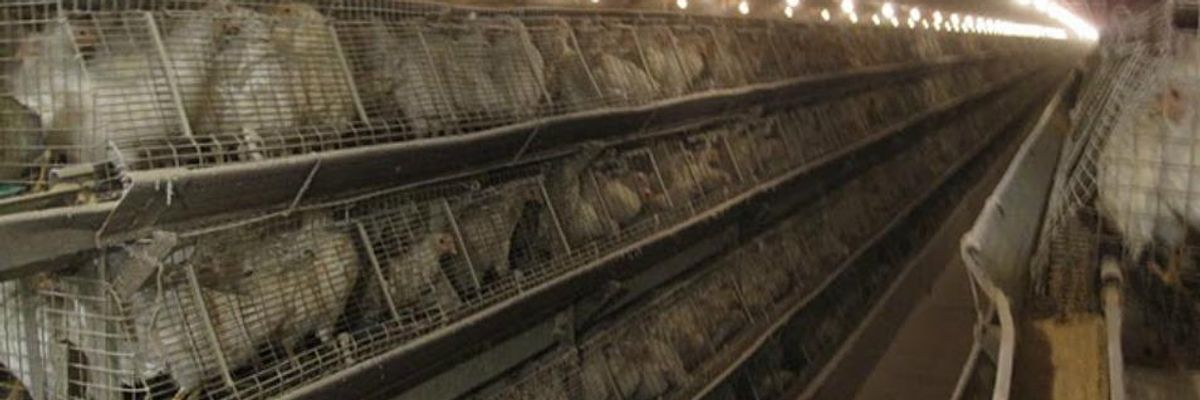We're a nation of animal lovers. We spend billions of dollars on our pets and call the animals in our homes members of our families. Throughout our country's history, we've enacted laws in every state criminalizing certain acts of cruelty, devoted resources to tackling animal fighting, risked our lives rescuing animals during disasters, and created thousands of animal protection charities for the purpose of alleviating animal suffering.
It's with this desire to protect animals from abuse in mind that we can address a modern-day hidden injustice. It's an injustice that when exposed, would repulse virtually all Americans. Quite simply, it's how animals in our food systems are abused.
The images of Old MacDonald's Farm may bring us warm thoughts of happy animals living on pasture, being cared for by a noble family farmer. Sadly, since World War II, this scenario has become more of a fairy tale than reality. The majority of our meat and eggs now come from massive windowless factory-like sheds. Farmers' pride in animal husbandry has been replaced with agricultural systems treating animals as if they were machines in an assembly line.
This movement within agriculture to de-animalize the animals comes at a time when we're learning some fascinating facts about these creatures. As a prime example, chickens have gotten a bad rap over the years. I'm a guilty as the next person of taunting, in my childhood, friends with the word "chicken." Perhaps "bok, bok!" came out of my mouth more than once. How can we empathize with these animals when we use their very name in such a mocking way?
Fortunately for our feathered friends, we're now learning thought-provoking things about these long-derided animals. Scientists have found that chicks even just a few days old are capable of counting up to ten. As they get older they develop different warning calls to their flock depending on whether the threat is coming from above--like a hawk--or on the ground--like a fox. And perhaps not so different from some human men, male chickens show preferential treatment to females, eagerly announcing morsels of food they've located to any hens in the vicinity, while staying silent about food found with only male chickens around. Talk about smooth players!
While things are looking up for these birds as our knowledge about their personalities and cognitive abilities grows, our treatment of them leaves much to be desired. In egg production, more than nine out of 10 chickens in the United States are confined in cages so small they can't even spread their wings. Each bird is provided less space than an iPad to live on for her entire life.
Chickens raised for meat in today's factory farms don't fare much better. They're confined inside giant sheds, packed by the thousands, forced to live on top of their own feces. In most cases, the buildings are cleaned infrequently, leaving the birds to live on the waste of generations of birds who preceded them.
Through genetic manipulation, a chick now grows into a mature chicken in just six weeks. The fact that chicken meat comes from baby chickens is not one that the meat industry talks about. The enormous physiological strain sometimes leads to deformed bones and torn tendons, and chicks sometimes even suffer heart attacks during their first few weeks of life-- an unheard of condition in baby animals in the natural world.
Another animal who feels the brunt of industrial animal agriculture is the pig. Like chickens, pigs haven't exactly been lionized in our society. Living in a "pig sty" or being called a "sow" is far from a compliment.
However, a new-found respect is accumulating for these misunderstood animals. Scientists have discovered that they're one of the smartest around. In video game tests between pigs and chimpanzees, pigs usually win. (If you're wondering, they use their mouths to control the joysticks.) And like the animals we're most familiar with, they enjoy playing with toys like balls, and use ropes to battle in tug-of-war. They respond to names they've been given and come when they are called.
Sadly, rather than acknowledging the mental acuity of pigs, the pork industry has moved in the other direction and treats them as if they were inanimate objects, "machines" as one pork industry article called them.
The sows known in the pork industry as "breeders" suffer the most appalling treatment. Confined for most of their lives in small cages called "gestation crates," the animals can't even turn around because these cages are barely larger than the pigs' own bodies. The cages seem more like medieval torture devices than animal housing equipment.
In America's meat and egg industries, it's usually the mothers and babies who are most exploited. Whether it's the egg-laying hens and breeding sows, when we take a moment to examine the situation, it's clear that there's something wrong here.
With that notion, more of us are making choices that have these animals in mind when we go food shopping for our families or sit down for a meal. Whether we take part in Meatless Mondays or the Vegan Before 6 diet recommended by New York Times food editor Mark Bittman, Americans are eating far fewer animals than we did just seven years ago. It seems that eating preferences like the Three Rs ("reducing" or "replacing" consumption of animal products, while "refining" our diets by switching to products from sources that adhere to higher animal welfare standards) are becoming more popular than ever.
To achieve historic social landmarks in the past, honorable Americans rallied, boycotted and some even paid the ultimate price with their lives. We don't need to make such sacrifices to help stop institutionalized cruelty to animals. When it comes to standing up for the caged hen who's trying her hardest to spread her wings inside her tiny cage, or the breeding sow still fighting against the bars of her cage to turn around, one of the most powerful tools we can wield is our fork.
